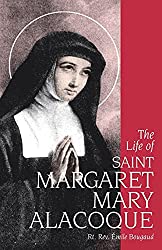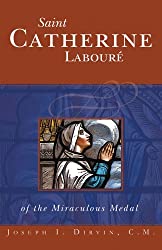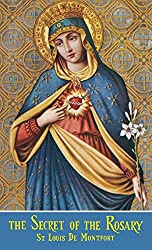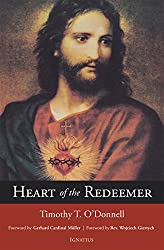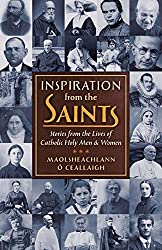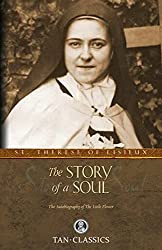
Hungry Souls is a wonderful testament to the reality of Purgatory. The author, Gerard J. M. Van Den Aardweg, has compiled a very honest, heartfelt account of the plight of the Holy Souls, written in a simple language, easily accessible to all.
And in my opinion, it is extremely successful. For after reading this book, one is left with a deep impression of the reality of the suffering existence of the souls in Purgatory and a longing to help them.
This work is like a mosaic of thoughts and ideas about Purgatory. And it could therefore be considered a compendium or anthology. For, throughout, Van Den Aardweg draws upon many sources: the writings of Saints and Church Doctrine, as well as from theologians, Popes and lay witnesses – all who illumine the reality of Purgatory.
And in so doing, he reinforces, in the mind of the believer, the importance for us to pray for these poor suffering souls.
The book begins with a short summary of the nature of Purgatory. The author then details certain personal accounts of near-death experiences and visitations to people by poor souls.
Carefully, he chooses to include only those experiences that he deems trustworthy. The book, then, aims to verify that these phenomena are real. For although the author seeks to enable understanding of Purgatory, he also wants to convince sceptics and non-believers of its reality.
The Reality of the Holy Souls and Purgatory
Whilst containing much that is rich, insightful and moving, this short book turns on three key themes. Firstly, that it is real and true that purgatory exists. Secondly, that it is real and true that certain poor souls have visited the living and implored help, providing proof to the third theme—that they truly suffer and desperately need our help.
These ideas echo again and again throughout the text. The author’s selected accounts only strengthen his argument, making more real the fact these poor souls exist, that they suffer and that they come to us to plead for help.
The author further invokes the connection between devotion to the Sacred Heart of Jesus and devotion to the Holy Souls in Purgatory. He suggests the two devotions were very much linked in the person of St. Margaret Mary Alacoque, who did indeed receive visitations from suffering souls, begging her to offer sacrifices on their behalf.
Van Den Aardweg cites Fr. John Croiset, St. Margaret Mary’s Spiritual Advisor, to illustrate this point:
The revelations she received about the sufferings of these souls, about our Divine Lord’s tender love for them and His eager desire for their deliverance, of the great efficacy of the devotion to the Sacred Heart for their early release, and the fact that [she] combined these two devotions so intimately … indicate that there is such a close connection between the two devotions that the devotion to the souls in Purgatory may be said to form a part of the devotion to the Sacred Heart.
At the book’s outset, Gerard Van Den Aardweg draws our attention to a neo-gothic church in Rome.
This Church, he writes, is ‘devoted to the Sacred Heart of Suffrage – suffrage in the meaning of help to the souls in purgatory.’
And he continues:
The church is a monument in honour of the mercy of the divine-human Heart of Christ for the souls in Purgatory, and at the same time, an invitation to the faithful to practice charity for them in union with His merciful Heart.

The book, then, features beautiful illustrations from this church of the Sacred Heart of Suffrage to aid an understanding of the theology of Purgatory.
For instance, there is a triptych above the main altar, which Pope Benedict XV described ‘a visual compendium of Catholic doctrine on purgatory.`
Housed within this church is a small and unusual collection of items, known as the Piccolo Museo del Purgatorio (Little Museum of Purgatory). Later in the book, the author devotes a chapter to the items displayed in this collection, showing how the Holy Souls appear to the living and the customary burn-marks left from their visits.
But let us stay with the first chapters, where we find accounts from people who have either witnessed death themselves or received visitations from those who have died and are suffering the fires of Purgatory.
On the Near-Death Experience

Van Den Aardweg uses a vivid near-death experience to illustrate that which tradition affirms about Purgatory. This is to say that, immediately on death, the soul experiences a powerful light.
This light, seen as an image or symbol of God, is everything the soul has ever longed for.
But the soul then retreats quickly from that light – to a place removed from it. It is a place where the light is continuously experienced in some way, constantly reminding the soul of that for which it yearns.
This retreating from God, in the form of this light, is necessary for each particular soul. This is in order that the soul suffers its just judgement, according to its sin, in the purificatory fires of Purgatory.
Yet, whilst this suffering fire is difficult, that which is far harder to bear is the separation from the light itself. The souls experience a deep, unbearable longing to be united with the light, with God.
To illustrate, the book features an account of a visitation from a soul in Purgatory – that of a Dominican Priest who regularly appeared to a woman. At one point, she asked him whether we contemplate God, immediately after death. The Priest responds, saying:
Yes, an awful shivering of the soul in adoration and then sinking away in the Purification.”
What is most striking is that he also says, ‘The more you love God, the greater the beatitude, act according to that!’ We return to these beautiful words, later on …
St. Faustina and St. Catherine of Genoa Testify to Purgatory
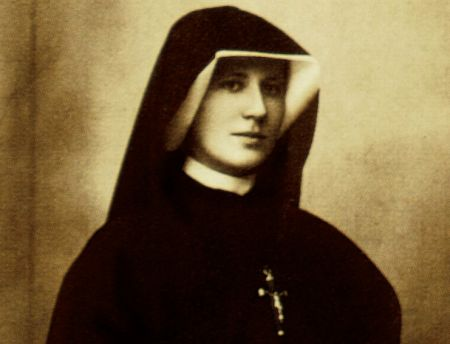
Another account of Purgatory comes from St. Faustina Kowalska. She speaks of how she was brought to the seat of judgement, before the Triune God:
I stood alone before the Lord. Jesus appeared such as we know him during His Passion …
Suddenly, I saw the complete condition of my soul as God sees it. I could clearly see all that is displeasing to God. I did not know that even the smallest transgressions will have to be accounted for. What a moment! Who can describe it? To stand before the Thrice-Holy God!
Jesus asked me, ‘Who are you?’ I answered, ‘I am Your servant, Lord.’
‘You are guilty of one day of fire in Purgatory’. I wanted to throw myself immediately into the flames of purgatory, but Jesus stopped me.
Van Den Aardweg uses such testimony to strengthen this idea of the soul’s longing to be united with God, so much so, that it is eager to suffer the flames of Purgatory. He writes:
St. Faustina transmits the awfulness of the soul’s confrontation with the Eternal, its insight that perfect holiness is required before it can enjoy God’s presence … and the instinctive impulse of the soul to be cleansed, even in the flames of Purgatory.
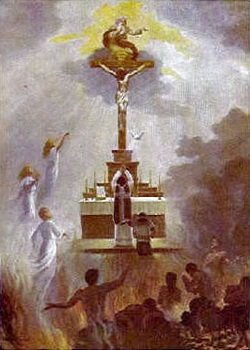
The author then deepens and extends this idea, bringing in a different perspective from the writings of St. Catherine of Genoa.
St. Catherine of Genoa apparently experienced the purificatory fires herself, whilst still living. She encountered the Holy Souls and their suffering, face to face. She saw how they came before God, immediately on dying, but were then filled with such guilt and shame – due to their imperfections – that they could not bear to remain in God’s presence.
The purificatory fire burns to cleanse the soul of these imperfections. According to St. Catherine of Genoa, this fire is the only place these poor souls want to be. For once cleansed, they will be pure in the face of God and then be able to enjoy the eternal banquet.
She therefore saw that the souls are content to suffer the fire – for they know it is the only way they will come to be with God. The fire is seen, therefore, as God’s love. He has had mercy on their souls and provides the means for them to be reunited with Him.
Of St. Catherine’s teaching, Van Den Aardweg writes:
The fire of Purgatory, which comprises the sufferings of the ‘pain of loss’ and the ‘pain of sense,’ is the fire of the love of God enkindled in the soul right after death. Then it sees itself and all its ‘rust of sin’ – which St. Catherine specifies as ‘the lower self in us…hidden flaws…[the soul’s unpaid] debt’ –in the light of God’s Presence.
Because she saw that the fire of purgatory was God’s merciful love, purifying each soul, she experienced that fire as joy.
Quoting St. Catherine, the author writes:
[The soul is] immersed in charity, incapable of deviating from it [and] can only will or desire pure love.
There is no joy save that in Paradise to be compared to the joy of the souls in Purgatory. This joy increases day by day because of the way the love of God corresponds to that of the soul, since the impediment of that love is worn away daily.
St. Francis de Sales was highly respectful of St. Catherine’s thoughts on Purgatory. As the author notes, he deemed them, ‘wonderful and very seraphic’, ‘pure inspiration and divine enlightenment.’ In fact, St. Catherine of Genoa became known as the Theologian of Purgatory.
On Supernatural Dangers
Whilst attempting to show how poor souls from Purgatory do indeed visit the living, Van Den Aardweg alerts people to the danger of being deceived. For souls can appear whose intentions are far from holy.
He warns, then, of the many manifestations of spirits claiming to be dear deceased friends or loved ones, where in fact they are anything but.
Despite this, he also wants to persuade sceptics of the reality of Purgatory. To this end, the author considers a Protestant man in Nineteenth Century Germany, who was convinced that the poor souls visiting him were ‘demons’. (For the Reformation had rejected belief in Purgatory.)
Yet whilst resisting belief in their pleas, the Protestant man wrote:
I … came under great pressure when I saw the sorrowful expression, the supplicating raised hands and the torrents of tears flowing from the eyes, and moreover heard sounds and sighs of anguish, desperation and supplication that would have softened a stone.
Whilst Protestants do not believe in Purgatory, the notion of these supplications ‘that would have softened a stone is only natural to we Catholics, almost instinctual to our very nature.
On Praying for the Holy Souls
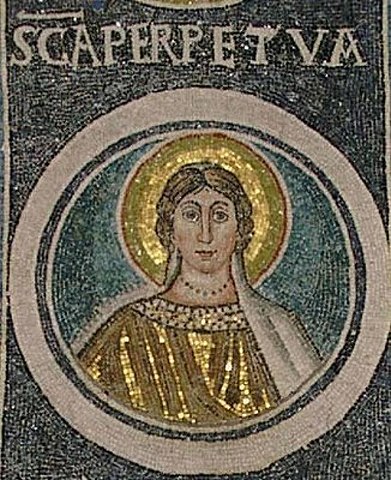
In exploring these themes, Van Den Aardweg considers how they have emerged in human thinking over the centuries.
For at least since the time of Plato, we have recognised ‘that our wrong doing must not only be forgiven but also be “made good,” expiated.’
This notion emerges as Van Den Aardweg writes of:
A moving early Christian account of a manifestation of a ‘poor soul’ … in the Acta of the martyrdom of St. Perpetua described by the young martyr herself in the year 202, during her stay in the dungeon before she and other Christians were thrown to the wild animals. In a vision she saw her deceased seven year old brother in a pitiful condition, in a gloomy place “with many others, flushed with heat, and thirsty.” There was a basin full of water, but its edge was so high that the boy could not drink.
Then I awoke and knew that my brother was suffering. But I trusted that I could help him out. And I prayed day and night for Dinocates, with sighs and tears, that he be given to me.”
Then St. Perpetua got a second vision and saw her little brother, healthy, freshly washed, and playing cheerfully. The basin had lowered, and he could drink as much as he wanted …“then I awoke and knew that my brother’s punishment was over.”
St. Perpetua’s prayers had ‘made good’ her brother’s wrong-doing and are an example to us of the efficacy of prayer for the Holy Souls.
As Van Den Aardweg continues his chronicle of Christian thought regarding Purgatory, we are brought to St. Ambrose, who stated that:
The souls in Purgatory pray for us so that we may recognise our sins and that what we do for them will be rewarded a hundredfold.
We will revisit this idea at the end, when we turn to the book’s conclusion …
Another wonderful advocate of this practice of praying for the Holy souls, found in this book, is St. Gertrude the Great. The author states that regarding the souls in Purgatory, Our Lord said to her:
It would not be in opposition to my justice to release them [the souls] immediately, if you would confidently pray for this purpose.”
Van Den Aardweg only heightens the importance of praying for the Holy Souls, with another account from St. Faustina. St. Faustina’s Guardian Angel led her to a vision of the Holy Souls in Purgatory, where she saw that
They were praying fervently, but without effect for themselves; only we can come to their aid.
And she said:
I asked these souls what their greatest suffering was. They answered me in one voice that their greatest torment was longing for God …
Since that time, I am in closer communion with the suffering souls.
In fact, St. Faustina continued the work of St. Gertrude, using her special prayer to aid the release of the Holy Souls from Purgatory.

On Penance, Prayers and Masses for the Holy Souls
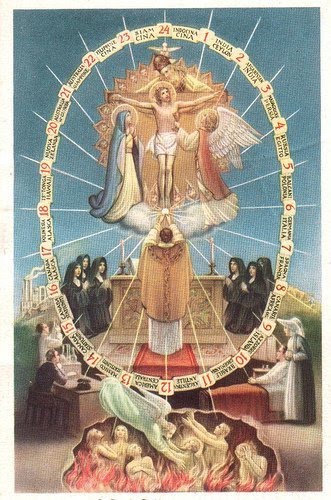
Van Den Aardweg extends these ideas of praying for the Holy Souls by turning to the Council of Trent:
Trent dogmatised what had been believed all along. First, although the guilt of a penitent sinner may have been forgiven, that does not mean that automatically all his “debt of temporal punishment” is discharged. In short, he may have to do penance in order to be purified, whether in this life or in the next: in Purgatory. Furthermore, the souls in Purgatory ‘are helped by the suffrages of the faithful, but particularly by the Sacrifice of the Altar’.
And to this the author later adds:
Since early Christianity, there has been unanimity that offering the Sacrifice of the Altar to the holy Trinity is the most beneficial suffrage for the poor souls.
Yet Van Den Aardweg states that other forms of prayer are also efficacious. He writes:
Poor souls indeed very often ask for holy Masses; but an expiatory act of high value is also the offering up of holy Communions, even of so-called spiritual communions. Furthermore, prayers, alms, indeed all acts of charity and all and every ordinary daily work; all mortifications and sacrifices that are offered to God for the relief or release of the suffering souls.
In a very moving account of a widowed woman, visited by the Holy Souls, we find many examples of this. The lady was asked by the Holy Souls to offer prayers and sacrifices, according to the particular soul’s needs.
For example, one soul asked for three Rosaries a day, another just one. Another soul had greatly sinned by avoiding good deeds, so asked for good deeds on his behalf.
The widow offered these very prayers and sacrifices and was greatly rewarded, by the souls’ liberation from Purgatory. She was also rewarded by news of her son – for she had been very concerned about her son’s fate, after his death, during battle.
After helping poor souls from her family, the widow received news of her son’s death from her deceased grandmother. Van Den Aardweg offers this moving description of his death:
You have always asked how it is with your son Jacob. You need not worry about him. This one is already altogether on high. He was lying a whole night in a shell crater, severely wounded. Then he called upon Jesus, if he might put his wounds in the wounds of Jesus. That way he dies. His guardian angel was permitted to bring him up straight away. His death was a death of sacrifice, taking part in the sacrifice of Jesus. Dying is beautiful if you love Jesus.
This final phrase, ‘Dying is beautiful if you love Jesus,’ reminds us of that striking message from the deceased Dominican Priest at the beginning of the book – “the more you love God, the greater the beatitude, act according to that!”
This is, of course, our goal, to love God with all our hearts, minds and souls. The greater our love for God, the easier it is for us to recognise and therefore avoid sin.
The call to love God naturally awakens a greater capacity for the recognition of sin and the consequential amendment of our lives.
As we have already quoted St. Ambrose, saying earlier:
The souls in Purgatory pray for us so that we may recognize our sins and that what we do for them will be rewarded a hundredfold.
In Conclusion – A Nun’s Tale of Her Father Released from Purgatory
Gerard Van Den Aardweg concludes his book with a remarkable testimony that only further amplifies these things. It concerns a young nun in the Ninteenth Century, whose recently-deceased father visited her regularly.
He seemed a grumpy, ungrateful soul. He frightened her, causing her to greatly suffer and continued badgering her for more prayers and sufferings on his behalf.
Yet, apparently, the father’s horror of purgatory was so intense, that even though he only had to endure it a short while, his suffering seemed unbearable.
But this was not the only reason he badgered his poor daughter. He did not want her to suffer these flames of purgatory and therefore saw that if she suffered for him now, her own time there would be lessened or removed altogether.
Yet, there is still more. On the day that he was released from purgatory – due to her prayers and sufferings – he appeared to her resplendent and beautiful and told her he would pray for her. His prayers would be far more efficacious, as he was now enjoying the company of the Saints in Heaven.
Van Den Aardweg writes of how the poor sister suffered terribly, so that she was even unable to visit the chapel. And yet:
On Christmas night, she succeeded on attending the Midnight Mass, which grace she attributed to the intercession of her father, from whom she expected to receive the announcement of his deliverance. And so it happened. Between the first and the second elevation of the Sacred Host, he appeared to her in supernatural splendour:
My punishment is ended. I come to thank you and your community for all the prayers said for me. From now on I shall pray for you all.
He then appeared to her again to assure her of his prayers and petitions on her behalf. Van Den Aardweg describes this apparition, where:
He was so resplendent that her eyes could scarcely bear the dazzling light. Her joy and happiness were now supreme. She felt ineffable peace of soul.
The fact that this young nun experienced such peace of soul, highlights the sense of rightness in what she had done by praying and suffering for her deceased father. It speaks of relationships and responsibility.
Just as we have responsibilities in life, for our children, spouses, parents, etc, we also have those same responsibilities in death.

And these responsibilities are gifts from God. They may be difficult; they may be joyous, but they all bring greater life-experience and opportunity for coming closer to God.
In this last account, the nun’s acts of suffrage for her father brought about such a longing for her to be united with God that it transformed her life.
It seems that the Holy Souls appear, first and foremost, to implore our help on their behalf. But, just as relationships in life are complex and multifaceted, so they remain after death.
These acts of prayer and sacrifice, on behalf of the Holy Souls, help us more than we can know. They help our own deliverance, by aiding us to grow in our love of God. They may cause us to suffer now (perhaps in a way that is more graceful) those impediments that will keep us from our heavenly goal, at our own death.
This simple book has impressed me deeply and catalyzed me into a daily relationship with the Holy Souls, where I offer prayers and sacrifices. I am very grateful to the author for giving me this opportunity to extend myself beyond the here and now, to that other world in which many of us will find ourselves one day – Purgatory.
Foreword for Monarchy by Roger Buck
Buying Books at Amazon Through These Links Gives Us a Commission. This Supports Our Apostolate. Thank You if You Can Help Us Like This!




